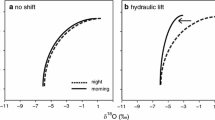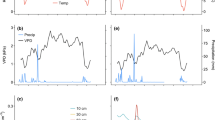Abstract
Hummock and hollow microtopography is pervasive in tidal freshwater swamps. Many tree species grow atop hummocks significantly more than in hollows, leading to the hypothesis that hummocks provide preferred locations for maximizing physiological proficiency of inhabiting trees that experience repeated flooding. We used thermal dissipation probes to measure the ecophysiological proficiency of a very flood-tolerant tree, Taxodium distichum, as manifested through in-situ changes in sapflow (a proxy for transpiration) in 11 trees on hummocks and 11 trees in hollows. Overall, sapflow increased significantly by 3.3 g H2O m−2 s−1 (11 %) in trees on both hummocks and hollows during flooding, contrary to our expectations. We found no significant differences in sapflow rates between T. distichum trees positioned on hummocks versus hollows in relation to discrete flood events. Coincidentally, hummock elevations were equivalent to the flood depths that promoted greatest physiological proficiency in T. distichum, suggesting a physiological role for the maintenance of hummock height in tidal swamps. While we reject our original hypotheses that flooding and positioning in hollows will reduce sapflow in T. distichum, this research reveals a potentially important feedback between hummock height, flood depth, and maximum tree physiological response.





Similar content being viewed by others
References
Allen JA, Pezeshki SR, Chambers JL (1996) Interaction of flooding and salinity stress on baldcypress (Taxodium distichum). Tree Physiol 16:307–313
Anderson CJ, Lockaby BG (2007) Soils and biogeochemistry of tidal freshwater forested wetlands. In: Conner WH, Doyle TW, Krauss KW (eds) Ecology of tidal freshwater forested wetlands of the Southeastern United States. Springer, Dordrecht, pp 65–88
Breden TF (1988) A tidal swamp forest in New Jersey. Bartonia 54:146
Clearwater MJ, Meinzer FC, Andrade JL, Goldstein G, Holbrook NM (1999) Potential errors in measurement of nonuniform sap flow using heat dissipation probes. Tree Physiol 19:681–687
Conner WH (1995) Woody plant regeneration in three South Carolina Taxodium/Nyssa stands following Hurricane Hugo. Ecol Eng 4:277–287
Conner WH, Toliver JR, Sklar FH (1986) Natural regeneration of baldcypress (Taxodium distichum (L.) Rich.) in a Louisiana swamp. For Ecol Manag 14:305–317
Conner WH, Doyle TW, Krauss KW (eds) (2007) Ecology of tidal freshwater forested wetlands of the Southeastern United States. Springer, The Netherlands
Cormier N, Krauss KW, Conner WH (2012) Periodicity in stem growth and litterfall in tidal freshwater forested wetlands: influence of salinity and drought of nitrogen recycling. Estuar Coasts. doi:10.1007/s12237-012-9505-z
Courtwright J, Findlay SEG (2011) Effects of microtopography on hydrology, physiochemistry, and vegetation in a tidal swamp of the Hudson River. Wetlands 31:239–249
Curran M (1985) Gas movements in the roots of Avicennia marina (Forsk.) Vierh. Aust J Plant Physiol 12:97–108
Day RH, Williams TM, Swarzenski CM (2007) Hydrology of tidal freshwater forested wetlands of the southeastern United States. In: Conner WH, Doyle TW, Krauss KW (eds) Ecology of tidal freshwater forested wetlands of the Southeastern United States. Springer, Dordrecht, pp 29–63
DuBarry AP Jr (1963) Germination of bottomland tree seed while immersed in water. J For 61:225–226
Duberstein JA (2011) Composition and ecophysiological proficiency of tidal freshwater forested wetlands: investigating basin, landscape, and microtopographical scales. Dissertation, Clemson University
Duberstein JA, Conner WH (2009) Use of hummocks and hollows by trees in tidal freshwater forested wetlands along the Savannah River. For Ecol Manag 258:1613–1618
Ford CR, Mcguire MA, Mitchell RJ, Teskey RO (2004) Assessing variation in the radial profile of sap flux density in Pinus species and its effect on daily water use. Tree Physiol 24:241–249
Gomes ARS, Kozlowski TT (1980) Growth responses and adaptations of Fraxinus pennsylvanica seedlings to flooding. Plant Physiol 66:267–271
Granier A (1985) A new method of sap flow measurement in tree stems. Ann For Sci 42:193–200
Granier A (1987) Evaluation of transpiration in a Douglas-fir stand by means of sap flow measurements. Tree Physiol 3:309–320
Hao G-Y, Jones TJ, Luton C, Zhang Y-J, Manzane E, Scholz FG, Bucci SJ, Cao K-F, Goldstein G (2009) Hydraulic redistribution in dwarf Rhizophora mangle trees driven by interstitial soil water salinity gradients: impacts on hydraulic architecture and gas exchange. Tree Physiol 29:697–705
Hook DD (1984) Waterlogging tolerance of lowland tree species of the south. South J Appl For 8:136–149
Horna-de-Zimmermann JV (1997) Effects of soil waterlogging on xylem flux density of two bottomland hardwood species. Thesis, Louisiana State University
Huenneke LF, Sharitz RR (1986) Microsite abundance and distribution of woody seedlings in a South Carolina cypress-tupelo swamp. Am Midl Nat 115:328–335
Jones RH, Lockaby BG, Somers GL (1996) Effects of microtopography and disturbance on fine-root dynamics in wetland forests of low-order stream floodplains. Am Midl Nat 136:57–71
Kludze HK, Pezeshki SR, Delaune RD (1994) Evaluation of root oxygenation and growth in baldcypress in response to short-term soil hypoxia. Can J For Res 24:804–809
Kozlowski TT (1984) Responses of woody plants to flooding. In: Kozlowski TT (ed) Flooding and plant growth. Academic, New York, pp 129–163
Kramer PJ, Kozlowski TT (1960) Physiology of trees. McGraw-Hill, New York
Krauss KW, Duberstein JA (2010) Sapflow and water use of freshwater wetland trees exposed to saltwater incursion in a tidally influenced South Carolina watershed. Can J For Res 40:525–535
Krauss KW, Twilley RR, Doyle TW, Gardiner ES (2006) Leaf gas exchange characteristics of three neotropical mangrove species in response to varying hydroperiod. Tree Physiol 26:959–968
Krauss KW, Young PJ, Chambers JL, Doyle TW, Twilley RR (2007) Sap flow characteristics of neotropical mangroves in flooded and drained soils. Tree Physiol 27:775–783
Krauss KW, Doyle TW, Howard RJ (2009a) Is there evidence of adaptation to tidal flooding in saplings of baldcypress subjected to different salinity regimes? Environ Exp Bot 67:118–126
Krauss KW, Duberstein JA, Doyle TW, Conner WH, Day RH, Inabinette LW, Whitbeck JL (2009b) Site condition, structure, and growth of baldcypress along tidal/non-tidal salinity gradients. Wetlands 29:505–519
Lu P, Urban L, Zhao P (2004) Granier’s thermal dissipation probe (TDP) method for measuring sap flow in trees: theory and practice. Acta Bot Sin 46:631–646
Mattoon WR (1915) The southern cypress. U.S. Department of Agriculture, Washington
McKee KL, Mendelssohn IA (1987) Root metabolism in the black mangrove (Avicennia germinas (L.) L): response to hypoxia. Environ Exp Bot 27:147–156
Megonigal JP, Conner WH, Kroeger S, Sharitz RR (1997) Aboveground production in southeastern floodplain forests: a test of the subsidy-stress hypothesis. Ecology 78:370–384
Naidoo G, Rogalla H, von Willert DJ (1997) Gas exchange responses of a mangrove species, Avicennia marina, to waterlogged and drained conditions. Hydrobiologia 352:39–47
Oren R, Phillips N, Ewers BE, Pataki DE, Megonigal JP (1999) Sap-flux-scaled transpiration responses to light, vapor pressure deficit, and leaf area reduction in a flooded Taxodium distichum forest. Tree Physiol 19:337–347
Parent C, Capelli N, Berger A, Crevecoeur M, Dat J (2008) An overview of plant responses to soil waterlogging. Plant Stress 2:20–27
Parker J (1950) The effects of flooding on the transpiration and survival of some southeastern forest tree species. Plant Physiol 25:453–460
Pereira JS, Kozlowski TT (1977) Variations among woody angiosperms in response to flooding. Physiol Plant 41:184–192
Peterson JE, Baldwin AH (2004) Variation in wetland seed banks across a tidal freshwater landscape. Am J Bot 91:1251–1259
Pezeshki SR (1987) Gas exchange response of tupelo-gum (Nyssa aquatica L.) to flooding and salinity. Photosynthetica 21:489–493
Pezeshki SR, DeLaune RD, Patrick WH Jr (1986) Gas exchange characteristics of bald cypress (Taxodium distichum L.): evaluation of responses to leaf aging, flooding, and salinity. Can J For Res 16:1394–1397
Poyatos R, Čermák J, Llorens P (2007) Variation in the radial patterns of sap flux density in pubescent oak (Quercus pubescens) and its implications for tree and stand transpiration measurements. Tree Physiol 27:537–548
Rheinhardt R (1992) A multivariate analysis of vegetation patterns in tidal freshwater swamps of lower Chesapeake Bay, USA. Bull Torrey Bot Club 119:192–207
Rheinhardt RD, Hershner C (1992) The relationship of below-ground hydrology to canopy composition in five tidal freshwater swamps. Wetlands 12:208–216
Santiago LS, Goldstein G, Meinzer FC, Fownes JH, Mueller-Dombois D (2000) Transpiration and forest structure in relation to soil waterlogging in a Hawaiian montane cloud forest. Tree Physiol 20:673–681
Schlesinger WH (1978) On the relative dominance of shrubs in Okefenokee Swamp. Am Nat 112:949–954
Stuckey BN (1982) Soil survey of Georgetown County. South Carolina. U.S. Department of Agriculture, Soil Conservation Service, Washington
Titus JH (1990) Microtopography and woody plant regeneration in a hardwood floodplain swamp in Florida. Bull Torrey Bot Club 117:429–437
Wullschleger SD, Hanson PJ, Todd DE (2001) Transpiration from a multi-species deciduous forest as estimated by xylem sap flow techniques. For Ecol Manag 143:205–213
Acknowledgements
Funding for this study was provided by the U.S. Geological Survey Climate and Land Use Change Research and Development Program and by NIFA/USDA, under project number SC-1700424. Technical Contribution No. 6104 of the Clemson University Experiment Station. Marshall “Craig” Sasser (U.S. Fish and Wildlife Service, Waccamaw National Wildlife Refuge) granted permission to conduct research on the refuge property. Nicole Cormier (U.S. Geological Survey, National Wetlands Research Center) assisted with the initial setup of the field study. Brian Williams and Stephen Hutchinson (Clemson University, Baruch Institute) helped with field data collection. Andy From (Five Rivers Services, LLC) helped develop the study area map. Scott Ensign (U.S. Geological Survey) and 2 anonymous reviewers provided very valuable feedback on early versions of the manuscript. Any use of trade, product, or firm names is for descriptive purposes only and does not imply endorsement by the U.S. Government.
Author information
Authors and Affiliations
Corresponding author
Rights and permissions
About this article
Cite this article
Duberstein, J.A., Krauss, K.W., Conner, W.H. et al. Do Hummocks Provide a Physiological Advantage to Even the Most Flood Tolerant of Tidal Freshwater Trees?. Wetlands 33, 399–408 (2013). https://doi.org/10.1007/s13157-013-0397-x
Received:
Accepted:
Published:
Issue Date:
DOI: https://doi.org/10.1007/s13157-013-0397-x




